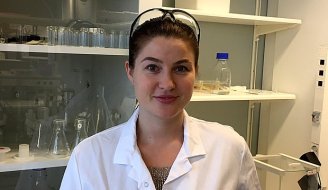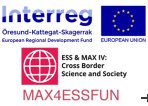Related News
Copyright 2012 neutronsources.org | All rights reserved. | Powered by FRM II | Imprint / Privacy Policy
EU Supports Next-Generation Neutron Science: Interview with Yana Znamenskaya
MAX4ESSFUN. Mucus protects many of our body’s vital functions against dehydration. Understanding the structure and function of this biological material will give researchers more tools to prevent and treat common diseases like cystic fibrosis and asthma.
Date: 27/03/2017
Source: europeanspallationsource.se

MALMÖ— As the focal point of the global neutron science community, the European Spallation Source (ESS) is preparing the next generation of neutron researchers to maximise the impact of the facility’s unique capabilities, unprecedented power and world-leading scientific instruments. This is happening locally in Sweden and Denmark through engagement with the many research universities clustered in Scandinavia.
To support those initiatives, the European Union programme Interreg Öresund-Kattegat-Skagerrak (ÖKS) is providing 50 percent matching funds for the €19 million programme ESS & MAX IV: Cross Border Science and Society, begun in 2015. The three-year programme is led by Sweden’s Region Skåne and co-lead partner Region Hovedstaden, in Denmark. It includes 27 partner organisations in Sweden, Denmark and Norway, and will continue through August 2018.
The flagship Cross-Border program is the €13.6 million MAX4ESSFUN. In cooperation with ESS and the MAX IV synchrotron in Lund, MAX4ESSFUN aims to build user capacity for the two facilities by directly financing experiment projects, training and supervision for PhD and postdoc researchers at eight universities in the ÖKS region.
The scope of the project is large, including 176 six-month-long experiment projects performed at operational neutron and light-source facilities and an educational component including courses, workshops and summer schools. Collectively, the project makes possible 1,000 months of training and 500 months of instructor time with senior researchers. Scientists at ESS acting as supervisors in the program are Pascale Deen, Zoë Fisher, Paul Henry (now a senior scientist at the ISIS Neutron and Muon Source in the UK), Andrew Jackson, Markus Strobl and Robin Woracek.
Originally from Russia, Yana Znamenskaya Falk did her postdoc at Lund University and is now a research scientist at Malmö University’s Biofilms Research Center for Biointerfaces. Her 2016 research on the structure of pig gastric mucin was supervised by scientists at Aarhus and Malmö Universities. This interview was first published in the ESS & MAX IV: Cross Border Science and Society newsletter on February 28, 2017, and has been lightly edited.
Young Scientists: Interview with Yana Znamenskaya
Experiment: Structure of pig gastric mucin at wide range of water contents and temperature
Experiment period: 2016-07-01 – 2016-12-31
Supervisor: Vitaly Kocherbitov, Malmö University
Co-supervisor: Jan Skov Pedersen, Aarhus University
Research with Focus on Mucin
In 2009 Yana Znamenskaya Falk moved to Sweden for a PhD study at Malmö University. In her PhD Yana chose to focus on the effect of hydration on the structural, thermodynamic and rheological properties of biopolymer mucin, which is a main component of mucus. Mucus is a slippery secretion produced by, and covering, mucous membranes. Yana is currently working at the Biofilms Research Center for Biointerfaces at Malmö University where she has continued her research study on mucin. In 2016 Yana participated in an experiment project within MAX4ESSFUN.
Yana explains that mucus consists primarily of water (95%), the glycoprotein mucin and other components and it can be found in all internal tracts of the body, f. ex. the mouth, nose, throat, sinuses, stomach and lungs. One of the essential functions of the mucous gel is protection of tissues against dehydration (drying). In order to fulfil this function, the mucous gel should be strongly hydrated, i.e. it should contain a large amount of water.
“In my PhD it was very interesting to investigate properties of native tissues, especially how the highly hydrated layer covering the mucosal surfaces of our body might be affected by changes at ambient condition. Understanding this can be relevant for areas like biomaterial coatings and drug delivery.”
Fruitful Collaboration Between Malmö and Aarhus Universities
One of the tasks of Yana’s research study has been to investigate how much water mucin could contain at different humidity levels, and what the effect is on mucin properties when humidity level is changed. For example, to get information about dependence of mucin phase behaviour from water content in the system, i.e. at which humidity levels a transition from glassy to elastic state occurs. In particular, dehydration changes the protective properties of the mucous gel and may become a pathogenic factor in many diseases such as cystic fibrosis, asthma, and gastric carcinoma. In order to avoid this, a further understanding of the mucin properties in mucous gel is required. Pig gastric mucin, which is very similar to human tissues, has been used for the samples. Another task has been to study how the structural properties of mucin are affected by hydration.
“In our Interreg project we did not apply for any experiments, as we had many X-ray data on mucin system, collected in Max lab, and it was important to evaluate them and to model the system. Mucin is a complex molecule, and its structure is yet to be defined. Therefore, we would like to know what type of structure pig gastric mucin has.”
According to Yana the Interreg project has been very important to move forward in understanding how the mucin system works.
“Thanks to the Interreg project I got the opportunity to not only meet but also collaborate with the world famous and brilliant scientist—Professor Jan Skov Pedersen—who can model any system. I also had the opportunity to travel to Aarhus University, to see their laboratory, experimental instruments and got to know Professor Pedersen’s group. I met a new contact there for powder diffraction experiments, which also can be useful in the future.”
Future Possibilities
In her research Yana is ready to use X-rays and applying for beam time at MAX IV would be a great step forward. Yana finishes her postdoc in April 2017, and what happens next depends on future funding.
“I definitely think MAX IV and the European Spallation Source will be important and useful facilities that will attract many brilliant scientists. If I stay in academia, there is no doubt that I will apply for beam time there to investigate my samples.”
Another future alternative could be to work within industry. Yana has already been in contact with pharmaceutical companies in Germany during her research.
“I think I would like to work in industry after my postdoc to be able to compare academic and industrial environments. I prefer to stay in Scandinavia, but you never know.”
Yana Znamenskaya Falk has an engineering degree from Kazan State Technology University in Russia. In 2013, Yana started her postdoc at Lund University’s Physical Chemistry department. Currently she is working as a research scientist at the Biofilms Research Center for Biointerfaces at Malmö University.
Text and interview: Kristina Sandberg Hrbinic, Project Secretary for ESS & MAX IV: Cross Border Science and Society
Links:
MAX4ESSFUN 2016 Annual Meeting Poster Book (25 MB)
EU Interreg ESS & MAX IV: Cross-Border Science and Society: www.scienceandsociety.eu/english
MAX4ESSFUN at University of Copenhagen website: max4essfun.ku.dk



